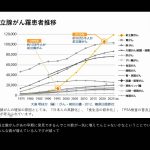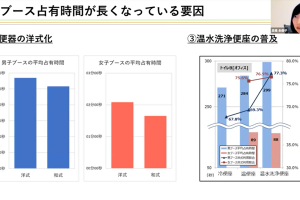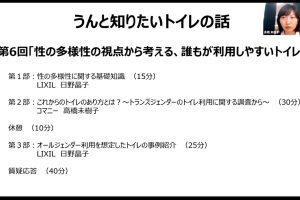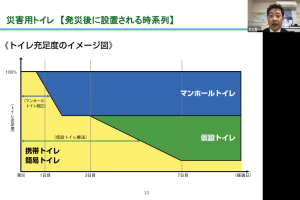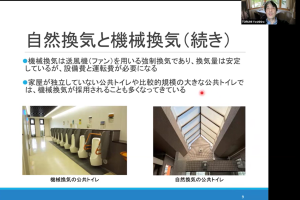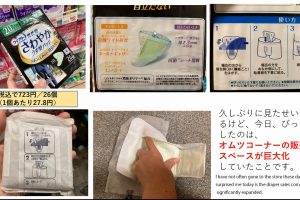The 15th seminar
“Even men require a litter box in the toilet !”
– Request for a gender-free sanitary bin! – Part2
Japan Toilet Association (JTA) Seminar Series
Date: 21 July 2022 (Thu) 18:00-20:00 JST
Presenters:
Mikiko Takahashi, Ph.D., Director of Japan Toilet Association,
R&D Section, R&D Headquarters, Company Co., Ltd.
Toyohiko Sunaoka (Taro Tora), Steering Committee member of Japan Toilet Association,
Former Director and Managing Executive Officer of Nikken Corporation.
Kohji Yamamoto, Ph.D., Director of Japan Toilet Association,
NEXCO Central Nippon Expressway Co., Ltd.
Organizer:
Yoshihiko Kawauchi, Ph.D., Japan Toilet Association vice chairperson,
Former professor of Toyo University.
1 : Overview
(Tora)
Everything started when TV master of the ceremony (MC) confessed in 2019 that he couldn’t control his urination and having trouble cleaning up the disposal of urine after the cystectomy operation.
There was a topic session at an online community called “Snack Aiko” hosted by Ms. Aiko Akiyama of the United Nations Economic and Social Commission for Asia and the Pacific (ESCAP) in December 2021. At that session many women participated surprised to know at first time that there is no sanitary bin in the men’s toilet cubicles.
Ms. Takako Otani, who has been contributed to the establishment of a bone marrow bank and the movement to install Wi-Fi environment in the hospitals, wrote about this matter in the Saitama Newspaper column.
The Japan Toilet Association (JTA) talked this issue on 21 February, 2022 in this seminar series in the response to the “Snack Aiko” talks.
At that time, we introduced the results of a questionnaire that we surveyed. The mass media began to report it widely, and sanitary bins have started to be installed in various places in Japan. Currently, seven prefectures; Saitama, Kanagawa, Aichi, Gifu, Tottori, Saga and Kumamoto have announced that sanitary bins will be installed in men’s cubicles at the prefectural public toilets. “be” special edition by the editorial department of Asahi Newspaper surveyed the situations covering 74 municipalities. Saitama prefecture declared that it is the largest number of the sanitary bins equipped area in Japan. Some private companies have already started to install them.
I investigated particularly the bladder cancer and the prostate cancer patients as the representatives who have trouble dealing with throwing away the absorbent of defecation.
The yearly number of the bladder cancer patients is 17,500 of men and 5600 of women. There are totally about 23,000 patients. This means about 100,000 patients among the total Japanese population, 120,000,000 must be suffering from the bladder cancer every five years in Japan. The prostate cancer is the top cancer rank disease for men. There were 92,000 men were diagnosed with the prostate cancer in 2018 and increased up to 105,000 in 2020. There are about 150,000 patients with the colorectal cancer in each year. About 260,000 patients are newly diagnosed with these three cancers in each year. All of them are suffering from the troubles with urine and excreting depending on their conditions. The number of the prostate cancer patients is rapidly increasing since it became possible to detect the prostate cancer at an early stage by means of the simple blood test now.
The sanitary bins are various sizes and shapes. It is a serious problem if people confuse it is an ordinally litter box and put foreign things in it. There are many trials to appeal such as an easy-to-understand indications; “This sanitary bin is for those who use defecation absorbent. Please wrap it in a paper and dispose.”
——————————————————————————————————-
2 : Quantitative analysis of the survey
(Takahashi)
I will introduce the results of a recent questionnaire survey titled “the Survey on measures for the excretion problems such as urinary or fecal incontinence and artificial anus when going out.” A primary survey was conducted in February 2022. This time is a more detailed following survey. Last time, we investigated firstly whether there were people suffering from using the defecation absorbent.
By this research, we realized that some people are facing troubles and the sanitary bins in the men’s cubicles are to install at many local governments to solve the troubles of them. This time we surveyed “What exactly they concern about?” “What kind of problems when they go out?” and “Which shape, size and function of the sanitary bin are necessary?”
[Brief review of the previous survey]
In the previous survey in February 2022, we conducted by means of the Internet questionnaire asking whether there were any people who had trouble with the lack of the sanitary bins in the men’s cubicle and then 333 males and 200 females replied.
12% of men and 16% of women among them had problems with the defecation and daily using the defecation absorbent. It turns out that there are a certain number of people regardless men or women use the defecation absorbents or diapers.
There was a tendency that older people use the defecation absorbents more.
24.1% used the diapers among 54 respondents in their 70s and above. The urine absorbents were commonly used for both men and women. 52.5% among men used the urine absorbents and 42.5% used the diapers that are no significant difference. Almost women used urine absorbents and a few used diapers. The reasons will be that women may have resistance to the diapers, and they think the urine absorbent is the extension of the sanitary pads which are commonly sold next to the sanitary product shelf.
In fact, some men said that they could not find a shop where the urine absorbent is sold.
Then next it is asked that “Have you ever had a trouble without a sanitary bin?” 68.4% of them answered that they had more than once experienced. In conclusion, there is a necessity to install the sanitary bins in the men’s cubicles as well as the women’s cubicles where they are commonly installed.
[About the survey of this time]
We surveyed with more detailed questions. For instance, “What kind of troubles do you have specifically?”, “How does the defecation trouble affect when going out?”, “What is the essential functions on the sanitary bins?” These questionnaires are targeting those who have defecation troubles and their caregivers. There were responses from 76 people who have defecation problems and their caregivers during from 18th June to 8th July, 2022.
64 had the defecation problems and 12 were caregivers among 76 respondents.
50% were male, 40.8% were female, and the rest were unknown.
As for the age group, there were many 40’s or older who have problems with the defecation.
This time, four people in their teens and 20’s responded, and three of them were the ostomates. (Ostomate is a person who has an artificial anus or an artificial bladder.) The questionnaire includes the urination troubles, defecation troubles, artificial anus, and bladder regarding the types of the excretion troubles. Some people had both urination and excrement problems as multiple answers were permitted. It seems the urination troubles tend to be more than the excrement troubles.
There were more men than women concerning the excretion trouble, however the reason is uncertain.
Unicharm Corporation investigated the excrement problems in 2017. It turned out nearly 30% of 20,000 adults experienced the excrement leakage in the survey. Some people were ashamed of the little blot on their underwear or staining their clothes.
More than 50% of both men and women with the defecation problems answered that they either frequently or sometimes gave up of going out. This problem cannot be solved by improving just toilets but it is necessary to improve the absorbent equipment.
When they were going out, 58.7% of the respondents answered that they always keep on looking for the toilet. Nearly 30% of respondents answered that even if they went to an entertainment place, they could not enjoy it at all due to the concern of the excretion. 14.7% of respondents gave up for going out.
We asked whether they use the absorbent products such as the diapers and urine absorbents, as well as the ostomate products against their incontinence problems. There was a difference between women and men responders. 28.9% of men always use them, while 74.2% of women do them. This seems to be influenced by the reality that women are accustomed to use it from their experience of the menstruation, and that they do not want to stain their clothes or underwear. 44.7% of men do not use it, which is much higher than that of women. The reason is uncertain. This is a summary report with the trend among only 21 respondents.
Reasons only by men not using the absorbent products were that the reluctance to use the products, lack of places to throw them away, and ignorance of the urinary absorbents and other products. Women’s cubicles are spontaneously installed the sanitary bins, but men’s cubicles are not yet. Those may be one of the reasons why they do not use it.
We asked people with the defecation problems that what kind of products they normally use. Women tend to use the urine absorbents more often than the diapers. Many women answered that they use the sanitary napkins not for the menstruation this time, but to prevent leakage of the urine and excrement.
We asked next about the troubles when using the absorbent products. The overwhelming majority of women are worried about the smell issue. The top problem by men was no place to throw away the pads. Almost all women said they had no problem to find a place to throw them away. This made it clear that men with such ailments face troubles because there are no sanitary bin in the men’s cubicle.
Next, we asked about what type of the cubicles they normally use. More than 50% of men answered that they use a wheelchair-accessible cubicle or a multi-purpose cubicle. 24.1% of women only used the multi-purpose cubicle, which means men use it more than 20% higher than women. When asked the reason why they use the multi-purpose cubicles, some answered that they needed more space. 25% men more than women answered that there is a useful sanitary bin for throwing away the pad in the multi-purpose cubicle.
There arises recently a problem that multi-purpose toilets are overcrowded. This could be also resolved by installing the sanitary bins in all men’s cubicles.
Next, we asked how they deal with things when there is no sanitary bin to throw away it in the cubicle. Majority people will bring it to the home, but there were some people who flushed it down to the toilet bowl or left it timidly in the cubicle.
If a sanitary pad is flushed down the toilet, it will get clogged and lead to malfunction. If there is a sanitary bin in the men’s cubicle, it is helpful not only for the users but also for maintenance.
When we asked if they will use it after installing, more than 90% of both men and women said they will. As for the place to install it, there are many requests that it is in each toilet cubicle inside, just like as the sanitary bins in the women’s cubicle. Therefore, it is ideal to be installed it in each toilet cubicle even in the men’s toilet.
We asked about the functions required for a sanitary bin such as the capacity, deodorizing, able to throw away without touching the bin, without exposing other contains when throwing away, cleanliness, and ease of use. The most notable one was its capacity. Especially women import on the capacity. It is also necessary to consider the capacity when installing a sanitary bin in the men’s cubicle. The frequency of cleaning also depends on its size.
When asked which place, they wish to install the sanitary bin, they replied such that the department stores, shopping centers, railway stations, airports, and the expressway rest areas.
There were slightly fewer requests for the installation of sanitary bins in toilet at workplaces and schools this time, but this is a trend among those who responded to this survey, and it shall be noted that workplaces and schools should not be left as an afterthought.
In summary, more than half of both male and female respondents answered that they have refrained from going out due to the continence problems. Some of them can not enjoy going out or hesitate to go out because of their continence problems.
Women tended to use the sanitary napkins to absorb urine and excrements. Some men did not know the absorbent pad or reluctant to use it.
Some people didn’t use the pad because they didn’t have a place to throw it away when they went out. Women answered that they did not have any trouble finding a place to throw them away, whereas men face problems.
There were many requests on the size of the sanitary bin.
——————————————————————————————————-
3 : Qualitative analysis of the survey
(Yamamoto)
On my part, I analyzed the attributes of those who had troubles in detail applying with the qualitative analysis method called Correspondence Analysis (CA) to figure out various needs.
Respondents were classified according to their behaving about their refrainment from going out due to the defecation problems.
For example, even women use various things such as thin or thick paper shorts and urine pads. We analyzed with CA between such gender and the absorbent pad users. As for the refraining from going out due to the defecation problems, there were categorized responses of “not at all,” “almost never,” “sometimes,” and “frequently.”
Those almost never refrain from going out are women who mainly use the sanitary pad or napkin or urine absorbent that can be thrown away in the sanitary bin in the cubicle. Some men answered that they normally wear the paper shorts and use mainly the multi-purpose toilets, so they answered that they have few or no troubles when going out.
On the other hand, those who answered “sometimes” or “frequently” refrained from going out wore thick shorts. There were some women who couldn’t throw it away in the current sanitary bin and some men who could not find a sanitary bin in the men’s cubicle, answered “sometimes.”
Then next, we analyzed the troubles when going out. There were many complains that they could not go out easily or find a toilet. There were many opinions that they couldn’t enjoy it all the time or they always keep on looking for a toilet. Some people who can’t enjoy or cannot go out, and use the bulky ostomate pouches by women, or catheters by men, and they worry to find a toilet to replace it.
The answers that always look for a toilet come from those who use thick paper shorts or the men’s shorts when going out. Some men who do not use the absorbent products have no concerns.
There is an opinion that people regardless of men or women have worries when they go out the limited places and they must consider the solutions.
Some male responders complained that the bin size to throw away the absorbents was too small or no place to throw them away and this was the trouble using the absorbent products.
There are many opinions that women are concerned about its smell. Women care more on it than men. Both men and women have the same problems such as smudged clothes, difficulty in disposing of the absorbent pad and bulky size.
Some women say there are no problem. Some men who wear the thin shorts do not have any problems since they use multi-purpose toilets. Nearly 70% of women normally use the women’s toilet cubicle, whereas nearly 60% of men use the multi-purpose toilet cubicle.
Men use multi-purpose toilet since there is a sanitary bin to throw away the dirty absorbent, but women pointed out there is no problem with the ordinary toilets since there is always a sanitary bin in the women’s cubicle. There were the other requests that both women and men need more space, and that is reason why they use multi-purpose toilets eventually. The other question is about handling the absorbent. Many of them dispose them during the journey, but some bring them back to the home or consider the travel plans so that they are not necessary to change it during their journey.
Many women answered that they dispose it into the sanitary bin during journey, but men did that they plan not to change it, or bring it back to the home. Some of the women using the thick shorts answered that they would take them home, since it is bulky to dispose in the sanitary bin and only way to bring them back to the home. Some of them wearing the thick shorts will use the multi-purpose toilets because it does not fit in a normal size sanitary bin.
Women’s sanitary products, napkins, and small urine absorbents can be thrown away in the normal sanitary bin, and then many say that there is no problem to throw them away.
On the other hand, there was an opinion that men’s paper shorts and urine absorbents shall be taken home, or be thrown away in the trash outside of the toilet cubicle or in the building litter. Some people struggled to find a place to throw them away since there is no sanitary bin in the men’s cubicle.
We asked both men and women will wish to use it after setting up a sanitary bin to throw away. We asked more about the most necessary functions for the sanitary bin for throwing away the absorbent products. They were the size, without odors or touchless. The top request was its large capacity. There was a strong demand for the prevention of odor leakage especially from women. There is also a request without touching the sanitary bin itself. But the prior request was to hide the inside of the bin. The collected request orders are from its size, deodorization to the smell leakage prevention.
In conclude both men and women demanded for the size of the sanitary bin to throw out the waste. Through this survey, we conclude that there were demands that the installation of the sanitary bin regardless of the absorbent types.
We predicted that many people would bring a small one to home, on the contrary we found out that there was a strong demand to throw it away during journey because they don’t want to bring back somewhat smells.
It will be necessary to re-consider whether all cubicles shall be equipped with the sanitary bins, since there are still only a few people use the absorbent.
Many people said that they would not like to be seen at throwing occasion by others, or that they would not want to carry around something smells, then if they can throw it away in the cubicle, they wish to throw them there.
Gathering these opinions, it is ideal to install a sanitary bin in all toilet cubicles, but if impossible, it is necessary to prioritize the requests.
——————————————————————————————————-
4 : Q&A selected
[Q1: Ak]It is very interesting result that the cause-and-effect quantitative relationship of being unable to go out because there is no sanitary bin in the cubicle.
How many participants are necessary to get reasonable results at the analysis?
I think it would be effective to do additional interviews with those who were distinguished among the respondents.
How about conducting a survey targeting at the participants who are cleaners and likely to against the installation of the sanitary bin? I think something good ideas may come out through such activities.
In addition, how about investigating the real situation of use at the local governments where is installed?
[A1-1: Yamamoto]
I asked a lot of questions in my analysis, such as age and details of the trouble. However, when I asked breaking it down into more details, the number of respondents may be just one eventually, and the statistical processing cannot be possible. Currently, there are less than 100 participants, and ideally, they are more than 200.
[A1-2: Takahashi]
Regarding individual interviews, the additional surveys are difficult, since we did it anonymously by asking about the sensible private questions such as the excretion.
[A1-3: Yamamoto]
We need to investigate the requests of the cleaners and the facility manager at the next step.
Additionally, there is a possibility that the daily garbage may be thrown away after installing it, and the voyeurism problem may happen. It is further necessary to hear the opinions of those who are worrying. We must ultimately listen to both requests of those who require the bin and the opposition at the final decision.
[A1-4: Tora]
I think it would be necessary to get together those who concern this issue to exchange opinions about the usage survey after installing the sanitary bin and unexpected usage.
The notice for use attached to the bin is currently written only in Japanese, but we must prepare the foreign languages and the proper display method for the visually impaired people.
[A1-5: Takahashi]
There are still many further things to do for this survey and Ms. Ak also asked what we must act after the results. There is a limitation to the activities and dissemination of such activities only by the Japan Toilet Association alone. We wish Ms. Ak also give us some advice on future activities.
[C1: Ak]
I think it would be possible to use various personal connections to gather leaders of the local governments and hold meetings to exchange their opinions.
Many people use multi-purpose toilets may be a problem for the people with disabilities. They require that it would be better to put the sanitary bin in the men’s cubicle.
[Q2: Ho]
Normally it is called “a litter box” in England because I have not heard “a sanitary box.”
[A2: Ai]
“A litter box” is literally a trash can. It may also be called “a waste bin.” Each native English-speaking country has various expressions, and then it may be “a litter box” as well. There may be something like an international standard terminology.
[Q3: Takahashi]
What is the status of overseas installations?
[A3-1: Ho]
There are no distinguish between men’s or women’s toilets but all cubicles in Sweden. There is a large size litter. It seems that it is possible to dispose anything without hesitation, including daily garbage.
[A3-2: Ak]
In Thailand, there is a small box in women’s toilets where only the paper is permitted to flush, and there is not in men’s toilets.
There is a waste bin something like a trash with an open lid and a plastic bag attached in both men and women toilets where even the paper is not permitted to flush for the cleaners can remove it easily.
[C4: Ka]
When there is a disposal, I am concerned about the sorting the garbage.
I wondered if it would be permitted to dispose of burnable and non-burnable garbage in the same place, or the sorting is required in the area.
[C5: Tora]
The actual situation is that the sanitary bins in the men’s cubicles installed are not yet fully used. Nihon Calmic Co., Ltd. manufactures a device that automatically packs women’s napkins, also collects them. It is working on recycling methods now. When miscellaneous garbage included, the extra work is required. I think it will be treated as a future issue.
[C6: Ya]
I think the garbage in the sanitary bin cannot be sorted for the hygiene reason. On the contrary, when there is a litter outside the toilet, it is necessary to separate them. PET bottles and other things are often thrown away in the toilet. It is necessary to consider about the total mechanism, such as placing a recycling box for empty containers outside the cubicle.
I am concerned when installing a box in a cubicle, various kinds of garbage will be put in there but nobody consider about that right now. I think that Japan is still behind in terms of the ingenuity of containers.
The pharmacies in Italy prepare the containers for the syringe needles, collection of leftover medicine and other items that can’t be open after once they’re put in. There is no such a thing in Japan. It is necessary to predict the frequency of cleaning, the capacity size of the bin and the maintenance frequency. It is also necessary to consider the tasks in total.
[C7: Fu]
I had an opportunity to talk with a staff of the local government who put sanitary bins in the men’s cubicles as a trial. However, there is still no record of the urine pads being thrown away in the sanitary bin in the men’s cubicle. They started to ascertain the real necessity. This situation may be partly due to the small number of patients. In this survey, some men do not use the absorbent even though they are in trouble when going out, because there are not well installed the sanitary bins.
It is an issue that how to solve the hidden needs and how the facility manager responds.
[C8: Tora]
Only nearly 70 municipalities in Japan have currently installed such sanitary bins. I think many people do not know there is a sanitary bin for throwing the absorbent in men’s cubicles. We can go out freely after everyone becomes have a common sense on this. I think that we must promote various activities until it becomes a common sense.
[C9: Su]
I think we need an environment where we can throw away things we want to. However, there must be hesitation to leaving it on the spot. It is necessary to consider the disposal method with ensuring the highest privacy and anonymity.
[C10: Kawauchi]
There is a paper towel to use in public toilet in America and there is a big trash to dispose them. Imaginably someone may put their personal trash there.
[C11: Ho]
A long roll-up towel is installed by pulling out in UK. Therefore, there is no litter bin for throwing them away. The situation is indeed different from country to country.


